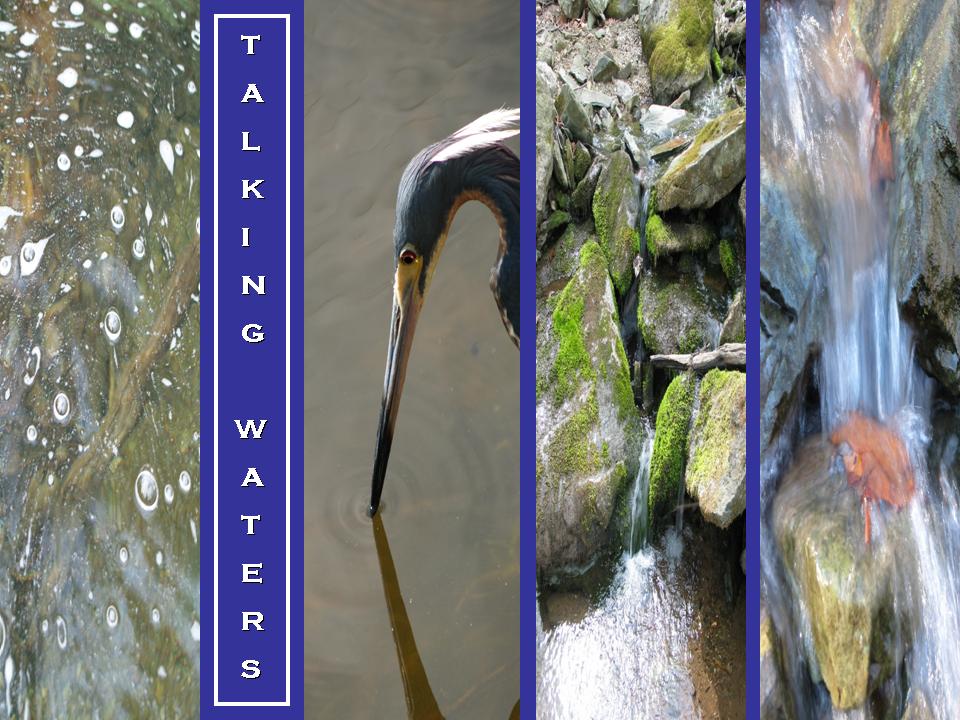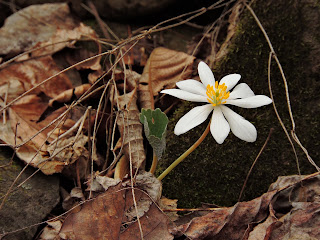Photo: (c) Jamie K. Reaser
In the Blue Ridge Mountains of Virginia, bloodroot (Sanguinaria canadensis), a white-petalled
member of the poppy family, is one of the first plants to emerge during the
waking of Spring. Hiking along the woodland trails, one finds it suddenly
there; clean, pure, declarative clusters breeze-dancing where not even a hint
of a flower occupied the dusty leaf litter the day before. The feet must stop.
The eyes and mind must fix to substrate. Mustn’t they? Yes. Change is
witnessed. Something new exists – flowers and season and possibilities. If you
listen closely, you can hear the tenor in the Hallelujah choir.
Emergence (Noun):
(a) The process of
becoming visible after being concealed.
(b) The process of coming
into existence or prominence.
Birds emerge – they pip their way out of shells
perfectly designed for the exchange of oxygen and carbon dioxide. Tadpoles
emerge – they wriggle forth from egg masses, pushing through a gelatinous
encasement that breathes while simultaneously buffooning voracious newts and
other would-be predators. Snakes emerge from skins too small. Butterflies and
moths emerge from capsules in which they become nameless between identities.
I have goats on my farm. In the middle of December in
2005, I found myself, quite unexpectedly, watching goat kids emerge from their
mothers’ wide-stretched vaginas. I had never before witnessed birth. It was
messy. It was systematically chaotic. It was a process.
There, in front of my crouched body, they landed, slimy-wet
and cloven, among the stiff spans of golden straw that I’d spread, in haste, to
gentle their arrival. I witnessed eight first breaths, the first crying out of eight
newly-defined selves, the first relational nuzzle of four mothers and four pairs
of siblings, twelve beings knowing – it seemed – precisely how to be what they
are – goats.
I was fascinated by where they had been before they emerged,
and what it was like there.
We humans emerge, too – over and over again.
We emerge from our own mother’s womb, from stages of
maturity, from relationships – some of us more scarred than others – from
sleep, out the front door, and from our lives into something so untouched by
our fright-constrained curiosities that we can describe it no better than, ‘death.’
In his poem, What
to Remember When Waking, David Whyte writes:
“To be human is to become visible
while carrying what is hidden as a gift to others.”
We must emerge to become human and be in service of
the world into which we have emerged. But, what of the hidden places? What of the dark, often nameless, places from
which we emerge?
What of the soil-world in which is nestled the
awaiting seed?
What of the interior of the egg, the cocoon, and the
chrysalis?
What of the occupied space in literal and metaphoric wombs?
‘Bardo’ is a Tibetan word for the ‘in-between’ or
‘transitional state.’ What of the bardos – all those periods in our lives in
which something has ended and something else has not yet begun, all those
places in our lives between where we have departed and where we have not yet
arrived, all the crises of identity in which we feel like ‘anonymous’ is the
old valid signature?
Yes, what of them? Looking downward and backward, I
conclude that we living beings fundamentally require the dark, the hidden, the
nameless, the indescribable – let me say ‘the mysterious’ – places and spans of
time in order to manifest something – ourselves – that can be seen, named,
described, and has the capacity to touch others in the light.
The known emerges from the unknowable.
If a “Hallelujah!” is appropriate for emergence,
what’s the best way to celebrate the in-between? I think, perhaps, it is
silence. No. It is a sacred silence, a silence infused with an inherent gratitude
for these places and these times that are the gestating, creative spaces in
which the blessed templates of what-to-come are scribed.
Sacred silence is not passive. ‘To be silent’ is a
verb phrase. Sacred silence requires intent and inner-action. It requires
receptivity and holding – actions that we humans don’t seem particularly well
versed at; otherwise we might not have such an aversion to silence, and the times
and spaces it demarcates.
Sacred silence is an offering. In reciprocity, the soul may sing to us the navigation
song meant to guide us across the wide-reaches of seemingly desolate terrain. Such
songs have enabled the Aboriginal Australians to cross the Outback deserts, Pacific
Islanders to precisely chart vast expanses of ocean, and curanderos to travel
from one realm to the next.
Upon reflection, I realize how often I have filled
what I thought to be life-voids not with sacred silence, but with words: words
of frustration, of anger, of accusation, of self-pity, of entitlement. I have
been known to scold the gods for the absence of things, including the clarity
of next steps – where to place my mind, my heart, and my feet.
In her book, When Things Fall Apart: Heart Advice for Difficult Times, Pema Chödrön observes:
“To
be fully alive, fully human, and completely awake is to be continually thrown
out of the nest. To live fully is to be always in no-man's-land, to experience
each moment as completely new and fresh. ”
It
would seem that we require life’s proverbial ‘no-man’s land’ in just the same
way that a fledging requires thin air. And, like the fledgling who must take a
leap of faith, we must lift each foot and, in turn, replace it in the detritus
of an unmarked trail.
Bloodroot garners its common English name from the
dark red-orange color of its rhizomes and the juice therein. The genus, Sanguinaria, means bleeding in Latin. In
the Algonquian languages it was known as poughkone – red dye
– a reference to one of its common uses. Native Americans also employed bloodroot
to treat fever, rheumatism, ulcers, and various skin ailments. In recent years,
the bloodroot has been commercially applied as an anti-plaque agent in toothpastes
and mouthwashes. Currently, it
is being studied for anti-cancer properties.
Bloodroot’s most potent gifts to humanity are hidden
in the darkness. And, it is darkness from which a single stem emerges to
support the pure, white declarative clusters that dance in the breeze.
~
Just a few feet down the path, I spot the first Hepatica blooms.
(c) 2014-2019/Jamie
K. Reaser
From "RidgeLines" (a work in progress)
Originally published in the Wayfayer literary magazine
Feel free to share










